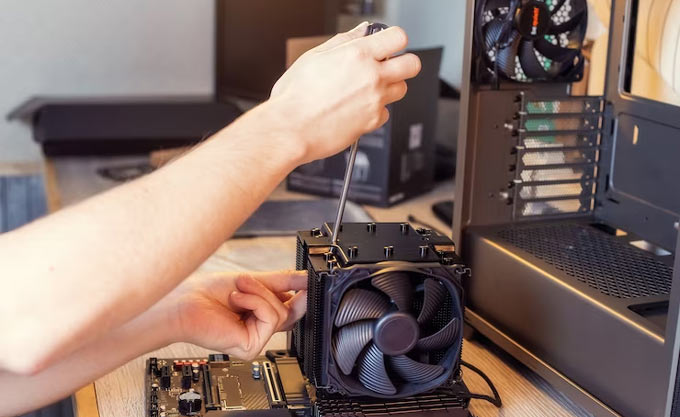Dealing with a troublesome CPU fan can disrupt your computer’s performance and stability. This article addresses the frustrations caused by CPU fan issues and provides insights into effective strategies for resolving them.
As a crucial component responsible for maintaining optimal temperature levels, a malfunctioning CPU fan can lead to overheating and system instability. By understanding common causes, troubleshooting methods, and potential solutions, users can navigate the challenges of CPU fan problems and restore their computer’s functionality.
This guide aims to help users tackle the annoying woes associated with CPU fan malfunctions and ensure smooth operation for their systems.
Table of Contents
Top Things That You Can Do To Fix CPU Fan Woes
Verifying that the CPU fan is functioning correctly is crucial for maintaining your computer’s performance and preventing overheating. Here’s how to check if the CPU fan is working properly:
- Visual Inspection: Open your computer’s case and visually inspect the CPU fan. Ensure it’s spinning smoothly without any obstructions or physical damage.
- Boot and Listen: Start your computer and listen for the characteristic whirring sound of the fan. If it’s silent or producing irregular noises, there might be an issue.
- BIOS/UEFI Settings: Access your computer’s BIOS/UEFI settings during startup and check the hardware monitoring section for CPU fan speed and status. Some systems provide real-time information about the fan’s performance. Remember these settings are sensitive and you are suggest to first backup the data. One of the best software to do so is Recoverit by Wondershare. With the help of Wondershare Recoverit coupon, you can also buy it at a low price.
- Software Monitoring Tools: Install monitoring software like SpeedFan or HWMonitor to track CPU fan speed and temperature. These tools offer real-time data on fan RPM and system temperature.
- CPU Temperature: Monitor your CPU’s temperature using the software. If the temperature rises significantly under load and the fan doesn’t speed up, there might be a problem.
- Fan Connector: Ensure the fan is securely connected to the motherboard’s fan header. Loose connections can lead to malfunction.
- Dust and Debris: Clean any accumulated dust or debris around the fan blades, as this can hinder proper airflow.
Regularly checking your CPU fan’s performance ensures timely detection of issues and helps maintain a stable and efficient operating computer system, especially when working with resource-intensive applications like Fusion 360.
If you’re looking for the best CPU for Fusion 360, it’s essential to ensure that your cooling system is functioning optimally. If you notice irregularities or suspect a malfunction, it’s advisable to address the problem promptly to prevent potential overheating and hardware damage.
Check The BIOS Settings
Checking the BIOS settings is a crucial step in ensuring your computer’s optimal performance and diagnosing potential issues. Here’s how to proceed:
- Access BIOS: Restart your computer and press the designated key (often F2, F10, Delete, or ESC) to enter the BIOS setup.
- Navigate to Hardware Monitoring: Locate the section related to hardware monitoring or fan controls. This might be named “PC Health,” “Hardware Monitor,” or similar.
- Check Fan Settings: Verify that the CPU fan settings are appropriately configured. Ensure the fan is set to “Enabled” and that the speed control is set to “Auto” or a desired setting.
- Monitor RPM: Some BIOS interfaces display real-time fan RPM (rotations per minute) values. Ensure that the CPU fan RPM is within a reasonable range, indicating proper functionality.
- Save and Exit: Save any changes you make to the BIOS settings and exit the setup.
By reviewing and adjusting BIOS settings related to fan control, you can effectively manage and optimize your CPU fan’s performance, contributing to a cooler and more stable computer system.
Update The Drivers For Your CPU Fan
Updating the drivers for your CPU fan is essential for maintaining optimal performance and resolving potential issues. Outdated or incompatible drivers can lead to fan malfunctions or inadequate cooling. To update the drivers:
- Identify Model: Determine your CPU fan’s model and manufacturer.
- Visit Manufacturer’s Website: Go to the manufacturer’s website and locate the support or downloads section.
- Download Latest Drivers: Find and download the latest drivers for your specific CPU fan model.
- Install Drivers: Install the downloaded drivers following the provided instructions.
Updating drivers ensures that your CPU fan operates at its best, contributing to efficient cooling and preventing potential overheating or performance problems.
Clean The CPU And CPU Fan
Regularly cleaning the CPU and CPU fan is essential to maintain proper cooling and prevent overheating. Dust and debris accumulation can obstruct airflow, causing the fan to work harder and less effectively. To clean:
- Power Off: Turn off and unplug your computer.
- Open the Case: Carefully open the computer case to access the CPU and fan.
- Compressed Air: Gently blow compressed air to remove dust from the CPU, fan blades, and surrounding areas.
- Avoid Static: Use an anti-static wristband or touch a grounded object to prevent static discharge.
- Reassemble: Close the case and plug in your computer.
Regular cleaning ensures optimal cooling performance, extends the lifespan of components, and prevents potential hardware issues due to heat buildup.
Conclusion
Addressing troublesome CPU fan issues is crucial to maintaining your computer’s stability and performance. By employing a combination of methods such as checking fan functionality, adjusting BIOS settings, updating drivers, and regular cleaning, you can effectively mitigate and resolve CPU fan woes.
Ensuring proper cooling not only prevents overheating but also contributes to a smoother computing experience, prolonging the lifespan of your hardware and promoting a reliable and efficient system operation.

